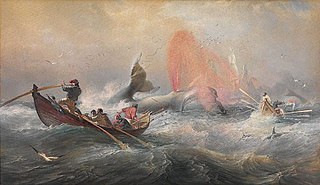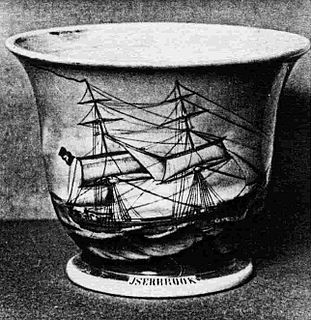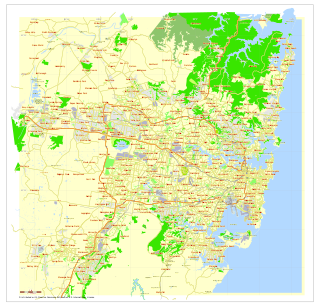
The Boyd massacre occurred in December 1809 when Māori residents of Whangaroa Harbour in northern New Zealand killed and ate between 66 and 70 Europeans. This is reputedly the highest number of Europeans killed by Māori in a single event in New Zealand, and the incident is also one of the bloodiest instances of cannibalism on record. The massacre is thought to have been in revenge for the whipping of a young Māori chief by the crew of the sailing ship Boyd.

The Colony of New South Wales was a colony of the British Empire from 1788 to 1900, when it became a State of the Commonwealth of Australia. At its greatest extent, the colony of New South Wales included the present-day Australian states of New South Wales, Queensland, Victoria, Tasmania, and South Australia, the Northern Territory as well as New Zealand. The first "responsible" self-government of New South Wales was formed on 6 June 1856 with Sir Stuart Alexander Donaldson appointed by Governor Sir William Denison as its first Colonial Secretary.

SS Wairarapa was a New Zealand ship of the late 19th century plying the route between Auckland, New Zealand and Australia. It came to tragic fame when it hit a reef at the northern edge of Great Barrier Island, about 100 km out from Auckland, and sank. The death toll of around 140 people remains one of the largest such losses in the country's history. The ship was named for the Wairarapa region.

Polly Woodside is a Belfast-built, three-masted, iron-hulled barque, preserved in Melbourne, Victoria (Australia), and forming the central feature of the South Wharf precinct. The ship was originally built in Belfast by William J. Woodside and was launched in 1885. Polly Woodside is typical of thousands of smaller iron barques built in the last days of sail, intended for deep water trade around the world and designed to be operated as economically as possible.

HMS Orpheus was a Jason-class Royal Navy corvette that served as the flagship of the Australian squadron. Orpheus sank off the west coast of Auckland, New Zealand on 7 February 1863: 189 crew out of the ship's complement of 259 died in the disaster, making it the worst maritime tragedy to occur in New Zealand waters.
George Raper was a Royal Navy officer who accompanied the First Fleet to Australia. He is known today for his watercolour illustrations, including the first depictions of the birds and flowers of Sydney Cove.

SY Aurora was a 600-tonne barque-rigged steam yacht built by Alexander Stephen and Sons Ltd. in Dundee, Scotland, in 1876, for the Dundee Seal and Whale Fishing Company. It was 165 feet (50 m) long with a 30-foot (9.1 m) beam. The hull was made of oak, sheathed with greenheart and lined with fir. The bow was a mass of solid wood reinforced with steel-plate armour. The heavy side frames were braced by two levels of horizontal oak beams. Her primary use was whaling in the northern seas, and she was built sturdily enough to withstand the heavy weather and ice that would be encountered there. That strength proved useful for Antarctic exploration as well and between 1911 and 1917 she made five trips to the continent, both for exploration and rescue missions.

Whaling in Australian waters began in 1791 when the 11 ships in the Third Fleet of settlers to the colony of New South Wales landed their passengers and freight at Sydney Cove and five of those vessels then left Port Jackson to engage in whaling and seal hunting off the coast of Australia and New Zealand. The two main species hunted by such vessels in the early years were right and sperm whales. Later, humpback, bowhead and other whale species would be taken.
Sydney Packet may refer to:
Sealing continues at Bass Strait and the Antipodes Islands. At the end of the year there is a new sealing rush to the Bounty and Auckland Islands. Few sealers, if any, are known to have visited the Foveaux Strait area at this time, although this may be due in part to the secrecy of the captains and owners in reporting where they operate and/or the existence of the Strait not yet being widely known. Whaling continues off the east coast of the North Island. Ships are now visiting the Bay of Islands on a reasonably regular basis. The first reports about the poor behaviour of ships crews are sent to the Church Missionary Society in London.
As most sealing is taking place in Bass Strait, although the rookeries there are declining, there is little interest in Dusky Sound, the rookeries of which are also declining. It is however still being used as a provisioning stop and rendezvous by sealers looking for new sealing grounds to the south and east of New Zealand. Foveaux Strait is discovered in December but its existence does not become widely known for some time. There is a marked increase in the number of whalers operating in the north of New Zealand, due in part to attacks on British boats in the South Atlantic as a result of the Napoleonic wars. There is also an increase in American ships from New England.
There is a lessening of the sealing rush at Bass Strait as the rookeries become thinner, and as a result sealers return to Dusky Sound and explore the surrounding coast. Little of the movements of these ships is actually recorded as a veil of secrecy still surrounds their activities while the various ships try to make the most of any discoveries before the competition arrives. They occasionally meet local Māori but little information regarding these encounters survives. There are again around half a dozen whalers off the north-east coast of New Zealand, a few of which call into the Bay of Islands. The first Māori to join a whaling ship, and possibly the first to leave New Zealand in 10 years, does so early in the year.
Charlotte Badger Is an English born Australian woman, widely considered to be the first Australian female pirate. She was also one of the first two white female settlers in New Zealand.
The Eleanor Lancaster was a 3-masted barque built at Maryport in 1839. Launched in 1840, and initially registered in Liverpool, it was operated by David Laidman (named after his wife, Eleanor Ann Hannah née Lancaster, with Captain P.Cowley as captain. In 1845, the ship was re-registered in London and was operated by Soutter & Co, with Captain Francis Lodge in command.

Iserbrook was a general cargo and passenger brig built in 1853 at Hamburg (Germany) for Joh. Ces. Godeffroy & Sohn. It spent over twenty years as an immigrant and general cargo vessel, transporting passengers from Hamburg to South Africa, Australia and Chile, as well as servicing its owner’s business in the Pacific. Later on, the vessel came into Australian possession and continued sailing for the Pacific trade. In 1878 it caught fire and was sunk the same year. At last, it was re-floated and used as a transport barge and hulk in Sydney until it sunk again and finally was blown up.
Whitby was a three-masted, square-rigger launched in 1837 and later re-rigged as a barque. She was registered in London, and made voyages to India, British Guiana, Australia, and New Zealand. In 1841 Whitby, Arrow, and Will Watch carried surveyors and labourers for the New Zealand Company to prepare plots for the first settlers. Whitby was wrecked at Kaipara Harbour in April 1853.

Orient was a clipper ship that traded between England and Adelaide from 1857 to 1877, and from which the Orient Line drew its name.

The New Zealand Company was a 19th-century English company that played a key role in the colonisation of New Zealand. The company was formed to carry out the principles of systematic colonisation devised by Edward Gibbon Wakefield, who envisaged the creation of a new-model English society in the southern hemisphere. Under Wakefield's model, the colony would attract capitalists who would then have a ready supply of labour—migrant labourers who could not initially afford to be property owners, but who would have the expectation of one day buying land with their savings.
Te Atahoe was a daughter of the Ngāpuhi chief Te Pahi. Te Pahi was one of the senior chiefs of the north-western Bay of Islands. He was the son of Wharerau, a descendant of the ancient ancestral Ngati Awa, Nga Puhi, Ngati Rehia, and Te Hikutu and Ngati Rua. Te Atahoe lived at Te Puna in the Rangihoua Bay area of the Bay of Islands and was also known as Mary Bruce.














